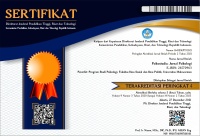The Digital Temptation: Adult Attachment Style and Commitment as Predictors of Online Extradyadic Involvement in Dating Partner
Abstract
The development of social media in the digital age has increased the likelihood of Online Extradyadic Involvement (O-EDI) or online infidelity, especially among young adults who are in romantic relationships. This phenomenon is influenced by psychological factors such as adult attachment style and commitment level, which play a role in determining an individual's vulnerability to O-EDI behavior. This study aims to examine the role of adult attachment style and commitment in predicting O-EDI behavior in individuals who are in romantic relationships in Indonesia. O-EDI is defined as emotional or sexual involvement online with someone other than one's primary partner, which is done in secret. A total of 172 young adult participants aged 20–38 years (M = 24.58) participated in this study. Commitment was measured using the Investment Model Scale subscale, while adult attachment style was measured using the Experiences in Close Relationships – Short Form. Multiple linear regression analysis was performed by controlling for demographic variables. Results show that the model with three predictors explains 38.1% of the variance in O-EDI, where attachment avoidance (β=0.258, p<0.05), attachment anxiety (β=0.220, p<0.05), and commitment level (β=-0.152, p<0.05) are significant predictors. Relationship duration and education also had an effect. These findings confirm that low commitment and high insecure attachment tendencies increase the risk of O-EDI in individuals in romantic relationships
Perkembangan media sosial di era digital meningkatkan peluang terjadinya Online Extradyadic Involvement (O-EDI) atau perselingkuhan daring, terutama di kalangan dewasa muda yang sedang menjalin hubungan pacaran. Fenomena ini dipengaruhi oleh faktor psikologis seperti adult attachment style dan tingkat komitmen, yang berperan dalam menentukan kerentanan individu terhadap perilaku O-EDI. Penelitian ini bertujuan menguji peran adult attachment style dan komitmen dalam memprediksi perilaku O-EDI pada individu yang menjalin hubungan pacaran di Indonesia. O-EDI didefinisikan sebagai keterlibatan emosional atau seksual secara daring dengan orang lain di luar pasangan utama yang dilakukan secara rahasia. Sebanyak 172 partisipan dewasa muda berusia 20–38 tahun (M = 24.58) berpartisipasi dalam penelitian ini. Komitmen diukur menggunakan subskala Investment Model Scale, sedangkan adult attachment style diukur dengan Experiences in Close Relationships – Short Form. Analisis regresi linear berganda dilakukan dengan mengontrol variabel demografis. Hasil menunjukkan model dengan tiga prediktor menjelaskan 38,1% variansi O-EDI, di mana attachment avoidance (β=0.258, p<0.05), attachment anxiety (β=0.220, p<0.05), dan tingkat komitmen (β=-0.152, p<0.05) menjadi prediktor signifikan. Durasi hubungan dan pendidikan juga berpengaruh. Temuan ini menegaskan bahwa rendahnya komitmen dan tingginya kecenderungan insecure attachment meningkatkan risiko O-EDI pada individu dalam hubungan pacaran
Keywords
Full Text:
FULL TEXTReferences
Adam, A. (2019). Perceptions of infidelity: A comparison of sexual, emotional, cyber-, and parasocial behaviors. Interpersona: An International Journal on Personal Relationships, 13(2), 237–252. https://doi.org/10.5964/ijpr.v13i2.376
Allen, E. S., & Baucom, D. H. (2004). Adult attachment and patterns of Extradyadic involvement. Family Process, 43(4), 467–488. https://doi.org/10.1111/j.1545-5300.2004.00035.x
Anantya, A., & Abdullah, M. N. A. (2024). Perceraian di era digital: Kasus Perselingkuhan menjadi tren di media sosial Dan Dampaknya. SABANA: Jurnal Sosiologi, Antropologi, Dan Budaya Nusantara, 3(2), 100–107. https://doi.org/10.55123/sabana.v3i2.3313
Anastasi, A., & Urbina, S. (1997). Psychological testing. Prentice Hall/Pearson Education.
Arantes, J., Barros, F., & Oliveira, H. M. (2020). Extradyadic behaviors and gender: How do they relate with sexual desire, Relationship Quality, and attractiveness. Frontiers in Psychology, 10. https://doi.org/10.3389/fpsyg.2019.02554
Arnett, J. J. (2000). Emerging adulthood: A theory of development from the late teens through the twenties. American Psychologist, 55(5), 469–480. https://doi.org/10.1037/0003-066X.55.5.469
Atkins, D. C., Baucom, D., & Jacobson, N. (2001). Understanding infidelity: Correlates in a national random sample. Journal of Family Psychology, 15, 735–749. doi:10.1037//0893-3200.15.4.735.
Belu, C. F., & O'Sullivan, L. F. (2024, MArch). Predictors of infidelity among couples. The Journal of Sexual Medicine, 270-272.
Bartholomew, K., & Horowitz, L. M. (1991). Attachment styles among young adults: A test of a four-category model. Journal of Personality and Social Psychology, 61(2), 226-244. https://doi.org/10.1037/0022-3514.61.2.226
Bergeron, S., Brassard, A., Mondor, J., & Péloquin, K. (2020). Under, over, or optimal commitment? attachment insecurities and commitment issues in relationally distressed couples. Journal of Sex & Marital Therapy, 46(3), 246–259. https://doi.org/10.1080/0092623x.2019.1683664
Blow, A. J., & Hartnett, K. (2005a). INFIDELITY IN COMMITTED RELATIONSHIPS I: A METHODOLOGICAL REVIEW. Journal of Marital and Family Therapy, 31(2), 183-216.
Blow, A. J., & Hartnett, K. (2005b). INFIDELITY IN COMMITTED RELATIONSHIPS II: A SUBSTANTIVE REVIEW. JOURNAL OF MARITAL AND FAMILY THERAPY, 31(2), 217-233.
Bozoyan, C., & Schmiedeberg, C. (2022). What is Infidelity?A Vignette Study on Norms and Attitudes toward Infidelity. THE JOURNAL OF SEX RESEARCH, 1-12.
Budyningrum, F. S., & Ariana, A. D. (2025). Psychological Distress of Female Young Adults Who Experienced Infidelity In Dating Relationships. Observasi: Jurnal Publikasi Ilmu Psikologi, 3(1), 287-293.
Cherry, K. (2024, October 25). Intimacy vs. isolation: Forming intimate relationships with others. Verywell Mind. https://www.verywellmind.com/intimacy-versus-isolation-2795739
Chopik, W. J., Edelstein, R. S., & Fraley, R. C. (2013). From the cradle to the grave: Age differences in attachment from early adulthood to old age. Journal of Personality, 81(2), 171–183. https://doi.org/10.1111/j.1467-6494.2012.00793.x
Collins, W. A., Welsh, D. P., & Furman, W. (2009). Adolescent romantic relationships. Annual review of psychology, 60, 631–652. https://doi.org/10.1146/annurev.psych.60.110707.163459
Drigotas, S. M., Safstrom, C. A., & Gentilia, T. (1999). An investment model prediction of dating infidelity. Journal of Personality and Social Psychology, 77(3), 509–524. https://doi.org/10.1037//0022-3514.77.3.509
Emery, L. F., Gardner, W. L., Carswell, K. L., & Finkel, E. J. (2021). Who are “we”? couple identity clarity and romantic relationship commitment. Personality and Social Psychology Bulletin, 47(1), 146–160. https://doi.org/10.1177/0146167220921717
Etcheverry, P. E., Le, B., Wu, T.-F., & Wei, M. (2012). Attachment and the investment model: Predictors of relationship commitment, maintenance, and persistence. Journal of International Association for Relationship Research, 1-22.
Faul, F., Erdfelder, E., Buchner, A., & Lang, A.-G. (2009). Statistical power analyses using G*Power 3.1: Tests for correlation and regression analyses. Behavior Research Methods, 41(4), 1149–1160. https://doi.org/10.3758/BRM.41.4.1149
Feist, J., Feist, G. J., & Roberts, T. A. (2018). Theories of personality (9th ed.). McGraw-Hill Education.
Jessica N. Fish , Thomas W. Pavkov , Joseph L. Wetchler & Jerry Bercik (2012): Characteristics of Those Who Participate in Infidelity: The Role of Adult Attachment and Differentiation in Extradyadic Experiences, The American Journal of Family Therapy, 40:3, 214-229. http://dx.doi.org/10.1080/01926187.2011.601192
Fitzgerald, C. J., Moreno, C., & Thompson, J. (2022). Predicting Online Infidelity. In The Oxford Handbook of Infidelity(pp. 153–171). essay, Oxford University Press.
Ghiasi, N., Rasoal, D., Haseli, A., & Feli, R. (2024). The interplay of attachment styles and marital infidelity: A systematic review and meta-analysis. Heliyon, 10(1). https://doi.org/10.1016/j.heliyon.2023.e23261
Gravetter, F. J. & Forzano, L. B., (2016). Research Methods for the Behavioral Sciences (5th ed.). Cengage Learning.
Gravetter, F. J., & Wallnau, L. B. (2017). Statistics for the behavioral sciences. Wadsworth: Cengage Learning.
Isma MNP, Turnip SS (2019). Personality Traits and Marital Satisfaction in Predicting Couples’ Attitudes Toward Infidelity. Journal of Relationships Research 10,e13, 1–5. https://doi.org/10.1017/jrr.2019.10
Kaplan, R., & Saccuzzo, D. (2009). Psychological testing: Principles, applications and issues. New York: Wadsworth Publishing.
Kaya, M. M., & Şakiroğlu, M. (2023). Factors affecting online infidelity: A Review. Psikiyatride Güncel Yaklaşımlar, 15(1), 29–37. https://doi.org/10.18863/pgy.1070731
Kemp, S. (2025, February 25). Digital 2025: Indonesia - DataReportal – global digital insights. DataReportal. https://datareportal.com/reports/digital-2025-indonesia
Kumar, R. (2011). Research Methodology: A Step-by-Step Guide for Beginners (3rd ed.). SAGE Publications.
Leadbeater, B. J., Connolly, J., & Temple, J. R. (2018). The development of romantic relationships in adolescence and emerging adulthood. In D. W. Osgood (Ed.), Contexts of adolescent development (pp. 195–215). Cambridge University Press.
Luo, S., Cartun, M. A., & Snider, A. G. (2010). Assessing extradyadic behavior: A review, a new measure, and two new models. Personality and Individual Differences, 49(3), 155–163. https://doi.org/10.1016/j.paid.2010.03.033
Martins, A., Pereira, M., Andrade, R., Dattilio, F. M., Narciso, I., & Canavarro, M. C. (2015). Infidelity in dating relationships: Gender-specific correlates of face-to-face and online extradyadic involvement. Archives of Sexual Behavior, 45(1), 193–205. https://doi.org/10.1007/s10508-015-0576-3
McAnulty, R. D., & Brineman, J. M. (2007). Infidelity in dating relationships. Annual Review of Sex Research, 18(1), 94–114. https://doi.org/10.1080/10532528.2007.10559848
McDaniel, B. T., Drouin, M., & Cravens, J. D. (2017). Do you have anything to hide? infidelity-related behaviors on social media sites and marital satisfaction. Computers in Human Behavior, 66, 88–95. https://doi.org/10.1016/j.chb.2016.09.031
Media Justitia. (2022, September 5). Asas Monogami Dalam Kitab Undang-Undang Hukum Perdata:Media justitia. Media Justitia | One Stop Legal Information. https://www.mediajustitia.com/edukasi-hukum/asas-monogami-dalam-kitab-undang-undang-hukum-perdata/#:~:text=Asas%20monogami%20dapat%20kita%20temukan,dengan%20satu%20orang%20lelaki%20saja.”
Mikulincer, M., & Shaver, P. R. (2007). Attachment in adulthood: Structure, dynamics, and change. Guilford Press.
Octaviana, B. N., & Abraham, J. (2018). Tolerance for emotional internet infidelity and its correlate with relationship flourishing. International Journal of Electrical and Computer Engineering (IJECE), 8(5), 3158–3168. https://doi.org/10.11591/ijece.v8i5.pp3158-3168
Panggabean, A. D. (2024, May 29). Ini Data Statistik Penggunaan Media Sosial Masyarakat Indonesia Tahun 2024. RRI.co.id. https://www.rri.co.id/iptek/721570/ini-data-statistik-penggunaan-media-sosial-masyarakat-indonesia-tahun-2024
Parker, M. L., & Campbell, K. (2017). Infidelity and attachment: The moderating role of Race/ethnicity. Contemporary Family Therapy, 39(3), 172–183. https://doi.org/10.1007/s10591-017-9415-0
Populix. (2024, October 31). 63% Generasi Muda Merupakan Pengguna aplikasi kencan online. https://info.populix.co/articles/generasi-muda-merupakan-pengguna-aplikasi-kencan-online/
Rediko, A. E. (2023, June 23). 5 Aplikasi Selingkuh paling aneh, chat Lewat Gojek Hingga google docs. Pikiran Rakyat. https://www.pikiran-rakyat.com/teknologi/pr-016810291/5-aplikasi-selingkuh-paling-aneh-chat-lewat-gojek-hingga-google-docs
Restya, W. P. (2019). Social media and marital infidelity. Proceedings of the 1st International Conference on Psychology, 106–111. https://doi.org/10.5220/0009438301060111
Rokach, A., & Chan, S. H. (2023). Love and Infidelity: Causes and Consequences. International Journal of Environmental Research and Public Health, 20(3904), 1-19.
Rusbult, C. E. (1980). Commitment and satisfaction in Romantic Associations: A test of the investment model. Journal of Experimental Social Psychology, 16(2), 172–186. https://doi.org/10.1016/0022-1031(80)90007-4
Rusbult, C. E., Martz, J. M., & Agnew, C. R. (1998). The investment model scale: Measuring commitment level, satisfaction level, quality of alternatives, and investment size. Personal relationships, 5(4), 357-387. https://doi.org/10.1111/j.1475-6811.1998.tb00177.x
Rusbult, C. E., Arriaga, X. B., & Agnew, C. R. (2001). Interdependence in close relationships. In G. J. O. Fletcher & M. S. Clark (Eds.), Blackwell handbook of social psychology: Interpersonal processes (pp. 359–387). Oxford, England: Blackwell.
Shaw, A. M., Rhoades, G. K., Allen, E. S., Stanley, S. M., & Markman, H. J. (2013). Predictors of extradyadic sexual involvement in unmarried opposite-sex relationships. Journal of Sex Research, 50, 598–610. doi:10.1080/00224499.2012.666816.
Syalwatyarsa, K., & Abdullah, M. N. A. (2024). Perceraian di era Digital : Menganalisis Faktor Dan Dampak Tren cheating Dalam Perspektif Demografi Sosial. SABANA: Jurnal Sosiologi, Antropologi, Dan Budaya Nusantara, 3(1), 39–48. https://doi.org/10.55123/sabana.v3i1.3310
Thornton, V., & Nagurney, A. (2011). What is infidelity? Perceptions based on biological sex and personality. Psychology Research and Behavior Management, 4, 51-58.
Vannier, S. A., & O’Sullivan, L. F. (2016). Passion, connection, and destiny. Journal of Social and Personal Relationships, 34(2), 235–257. https://doi.org/10.1177/0265407516631156
Vaughan, P. (2004). Online Affairs. San Diego, CA: Dialog Press.
Wei, M., Russell, D. W., Mallinckrodt, B., & Vogel, D. L. (2007). The Experiences in Close Relationship Scale (ECR)-Short Form: Reliability, Validity, and Factor Structure. Journal of Personality Assessment, 88(2), 187–204. https://doi.org/10.1080/00223890701268041
Whitty, Monica Therese. (2003). Pushing the wrong buttons: Men’s and women’s attitudes toward online and offline infidelity. CyberPsychology & Behavior, 6(6), 569–579. https://doi.org/10.1089/109493103322725342
Whitty, M. T., & Quigley, L. (2008). Emotional and sexual infidelity offline and in Cyberspace. Journal of Marital and Family Therapy, 34(4), 461–468. https://doi.org/10.1111/j.1752-0606.2008.00088.x
DOI: http://dx.doi.org/10.30872/psikostudia.v14i4.21337
Refbacks
- There are currently no refbacks.
Copyright (c) 2025 Shinta Saraswati & Yudiana Ratnasari

This work is licensed under a Creative Commons Attribution-ShareAlike 4.0 International License.
Psikostudia: Jurnal Psikologi is indexed by :
PSIKOSTUDIA: Jurnal Psikologi Published by Faculty of Social and Political Siences, University of Mulawarman, Samarinda, East Kalimantan and This work is licensed under a Creative Commons Attribution-ShareAlike 4.0 International License.
_________________________________________
PSIKOSTUDIA: Jurnal Psikologi
Department of Psychology
Faculty of Social and Political Siences, University of Mulawarman
Jl. Muara Muntai Kampus Gn. Kelua Samarinda 75411
Phone: +62 813 35350368
E-Mail: psikostudia@fisip.unmul.ac.id




















